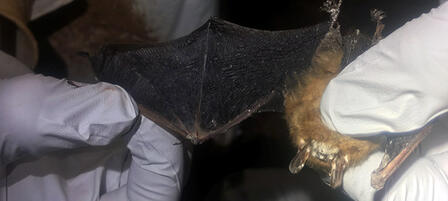Bats With White-nose Syndrome Detected In Kansas

PRATT – White-nose syndrome (WNS), a fungal disease that affects hibernating bats, has recently been confirmed in Kansas – the 32nd state to confirm the presence of the disease. Several dead bats, collected during cave surveys in Cherokee County in southeast Kansas and Barber County in southcentral Kansas, tested positive for the disease. Surveys were conducted between February 14 and March 1, and samples were tested by the U.S. Geological Survey (USGS) National Wildlife Health Center in Madison, Wis.
WNS is not known to pose a threat to humans, pets, livestock, or other wildlife and fish. The fungus that causes WNS is spread through bat-to-bat contact, but not all bat species are affected equally.
WNS is named for the white fungal growth often observed around the nose of infected bats. The fungus can invade the skin of hibernating bats and cause damage to the wings. It also induces unusual behaviors, such as bats prematurely leaving hibernation, using up fat reserves necessary to survive winter – when conditions are harsh and food (insects) scarce – resulting in death.
WNS was first detected in New York in 2007 and has since killed millions of bats in states and Canadian provinces where it has been found. States surrounding Kansas, including Missouri, Nebraska, and Oklahoma, have also detected either the fungus that causes WNS or the disease itself.
“Detection of white-nose syndrome in a new state underscores the critical importance of work to develop tools for early detection and rapid response to this devastating wildlife disease," said USGS scientist Anne Ballmann. “The USGS will continue working with resource managers to help conserve imperiled bat species.”
In 2014, the Kansas Department of Wildlife, Parks and Tourism (KDWPT) began working with private landowners to enter caves, survey bats and check for the fungus. No positive test results were found until this year. Biologists with KDWPT’s Ecological Services Section, alongside other scientific groups, will continue survey efforts, but they’ll need the help of willing landowners to locate and enter bat caves.
Of the more than 1,000 species of bats around the world, 15 have been found in Kansas. Big brown bats are the most common and widespread species in the state and live here year-round. WNS has not been documented in big brown bats in Kansas. Big brown bats can eat about one-third of their weight each night while feeding on insects. Collectively, bats play a vital role in the Kansas ecosystem by consuming millions of insects each year, including agricultural pests and mosquitoes. Studies indicate bats have saved U.S. farmers billions of dollars in pest control services.
While there is no known cure or treatment for WNS, wildlife experts encourage those who enter bat caves to follow decontamination protocols to help reduce and/or prevent further spreading of the fungus. Suggested decontamination protocols can be viewed at https://www.whitenosesyndrome.org/resource/united-states-national-white-nose-syndrome-decontamination-protocol-april-12-2016. If a sick bat is found, take a photo and document the location, and e-mail KDWPT ecologist Samantha Pounds at samantha.pounds@ks.gov or KDWPT.ess@ks.gov
Information about white-nose syndrome can be found at www.whitenosesyndrome.org. For more information about WNS in Kansas, e-mail Pounds at samantha.pounds@ks.gov or KDWPT.ess@ks.gov.
For media requests, contact the KDWPT Ecological Services Section at (620) 672-5911.
(Grant provided funding – Endangered Species Recovery Implementation Funds, CFDA Program #15.657.)
-30-









